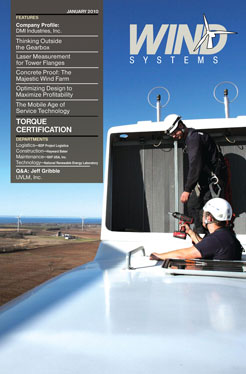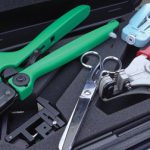When people think about windpower generation, the first thought usually extends to the blade cutting through the breeze, the aerodynamic turbine capsule, or the 300-foot tower. Torque and its precise measure of fastener tension is the last thing on anyone’s list. But when it comes to ensuring that those giant blades keep turning and the ubiquitous towers remain standing, torque really is the most important component in the mix. And that’s why Snap-on Industrial, in conjunction with education and industry partners, has spearheaded a torque certification training program as part of a technical school or junior college curriculum. As a result of conversations about training requirements with representatives from industry segments that range from auto repair to renewable energy, Snap-on Industrial representatives actively engaged wind-industry experts about specific skill requirements for the next generation of workers. And in many of those conversations, safety and torque were at the forefront of training issues marked as critical—whether that’s preparing young workers new to the workforce, or retraining workers from industries hard hit by the economy for jobs in windpower maintenance.
Defining Torque
Torque is the twisting motion used to tighten or secure a fastener. The amount of force used in a particular task is measured in Newton meters or foot pounds. The Snap-on Industrial torque certification program explores both torque theory and proper use and application of equipment. Testing for the certification focuses on equipment use. (see Fig. 1)
The understanding and proper application of torque is a mission-critical element of a viable and sustainable windpower industry in the United States. Industry leaders know that strong training programs are necessary to meet the burgeoning demand for manpower. Government and industry estimates put the manpower requirement for professional windpower technicians at more than 180,000 by 2030, when windpower is expected to provide 20 percent of the United States’ electric power (statistics from the U.S.
Department of Energy study, 20% Wind Energy by 2030, May 2008). Currently, there are about 30,000 windpower technicians working in the U.S. The curriculum is straightforward and understood by all those who work in industrial settings or industries such as wind. It’s a step-by-step program outlining what a bolt is, how threads impact the strength of the attachment, which materials work together, and which ones don’t.
The examples are simple: When you take a grade-eight bolt and put a grade-five nut on it, you can no longer torque the bolt to the same torque levels as when you use a grade-eight nut. There is a difference in heat treatment, and a difference in strength between the fastener grades.
Training explains the differences between various fasteners and shows participants how to determine fastener grades. And there are different kinds of torque equipment, as well, including mechanical torque, electronic torque, and what’s referenced as high torque; a pump that uses hydraulic fluid and air to accomplish the torque value required. For one-inch bolts and larger fasteners, that’s 5,000 psi and up.
The aim of the training program is to ensure that the worker knows that when he’s putting a flange together there’s a sequence for the bolts, there’s recognition about the type of bolt used, and there’s a specific torque value for that bolt. These workers need to know the proper torque sequence and how to apply the same amount of pressure on each fastener so that a strong attachment of the flange is achieved. Using the correct procedure for flange attachment, the piece is torqued two or three times before it gets to maximum torque. It’s not like a car, where the technician may torque a bolt on a wheel to maximum value only once. In an industrial setting or in the wind industry, tolerances are such that a given piece may require torquing up to five times for a single bolt. Workers need to know that if you don’t follow this process, you could create a gap on one side of the flange or another that allows a leak or oxidation. (see Fig. 2)
Torque certification is built around certifying that workers understand the technique of torque and the consequences of improper torque application. For example, they need to know when and when not to put oil on bolts or to use of a seizing material when working on a gasket. In applications that require a gasket, it may be necessary to pre-torque the bolt before a liquid additive is applied and final torque application is made. Many times auto technicians diagnose component problems; they may have to remove the part and replace it. It’s critical to apply manufacturers torque specifications to help ensure that the vehicle doesn’t return with the same problem because of an incorrect torque value.
Professionals in the windpower industry, and other industrial segments, learn on the job and may not have been taught properly from the start. It’s the job of technical education professionals working with industry leaders to show them the right way to torque a fastener.
Taking Shape
Working with partner schools that already have training programs for automotive technicians, Snap-on representatives talked about torque certification courses tied to the expressed needs of other industries, particularly the wind industry. This group of colleges provided technical instruction expertise and facilities, while Snap-on Industrial and its partners brought comprehensive theory, real-world application knowledge, technical experts, and equipment to the table. The result is a melding of academic culture, field knowledge, and world-class technologies focused on best-practices for fastener use. (see Fig. 3)
The group even looked outside the U.S. for guidance. In the province of Alberta, Canada, Lethbridge College is working with European partners to expand upon its popular and growing wind technician training program. Instructors there have stated that there are three core maintenance requirements in the turbine and on the tower that they preach: lubrication, cleaning, and torque. That’s it. Finally, there are monetary interests in all of this training. States have both a social and an economic incentive to support these training programs, which will retrain displaced workers and attract new investment to the state. To ensure that a healthy environment for retraining and reinvestment exists, the technical education system needs to be in place so that when companies come forward, the infrastructure is ready. Windpower is clearly a growth industry since the U.S. has reached only 5 percent of its goal objective for energy derived from wind to date.
The Program
The 16-hour torque certification course is designed as a component of an existing windpower technician training course, but the program is flexible enough to be applied as a standalone course. The curriculum includes modules on theory, technique, mechanical torque wrenches, electronic torque wrenches, hydraulic torque wrenches, torque multipliers, and safety. The program covers every aspect of torque, from the basics through master-level skills. Current standard windpower technician curriculum incorporates study of electrical and electronic components, electrical safety, working in confined spaces, and working at height. The Snap-on torque certification program is integrated into windpower technician courses currently available at Lakeshore Technical College in Cleveland, Wisconsin; Gateway Technical College in Kenosha, Wisconsin; and the multi-campus Frances Tuttle Technology Center in Oklahoma.
Completion of this course gives participants an advantage over others who do not opt for torque certification. These workers can go anywhere, into any industry, and immediately show that they have the skill set necessary to perform certain kinds of jobs. It’s like having a college degree and being considered for a job along with someone who has no college training. There’s no comparison.
Summary
Torque training in the windpower industry is part of an ongoing, sustained American effort to tap renewable energy sources in the years ahead. Site selection and building the mechanisms to harvest wind and solar energy is important. But it does not supersede—and in some ways is subordinate to—the requirements for ongoing maintenance and support. Maintaining necessary structures over a long period of time falls to the knowledge and skill of trained professionals, technical personnel who know how to use tools to prevent small issues before they become production stoppers. Torque certification plays an important role in developing those skilled technical professionals.








































